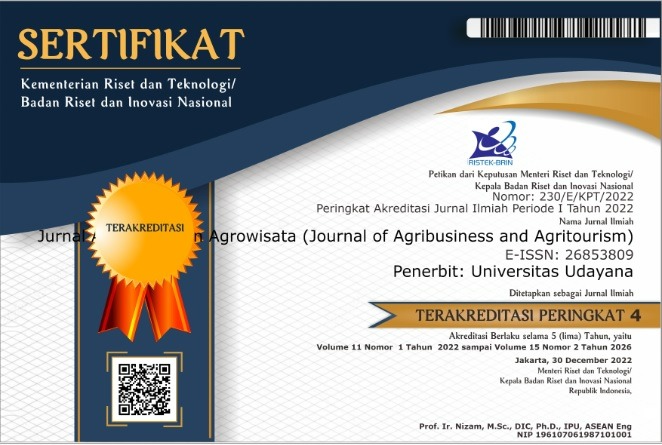Strategi dan Struktur Nafkah Rumah Tangga Petani Jeruk di Kecamatan Bangli, Kabupaten Bangli, Provinsi Bali
Abstract
Strategy and Income Structure of Household Orange Farmers in Bangli District, Bangli Regency, Bali Province
Oranges are seasonal plants that will bear fruit when the season arrives. Citrus farmers always go through a period of waiting for harvest in this condition, they do not receive income from citrus farming. Various challenges and risks require citrus farmers to implement livelihood strategies. The implementation of a livelihood strategy utilizes the livelihood capital owned, namely: human, social, physical, financial and natural capital. This study aims to identify the livelihood capital and analyze the strategy and structure of the household income of citrus farmers in Bangli District. The selected sample is 30 respondents taken purposively, namely farmers with the criteria of having citrus plants that have been producing. Analysis of the data used is descriptive quantitative analysis by identifying livelihood capital and analyzing livelihood strategies and structures. Capital and livelihood strategies are divided into low, medium, high categories. The income structure is divided based on the area of citrus land ownership. The results showed that the livelihood capital of citrus farmers, namely social and financial capital, was high, human capital was moderate, physical capital and natural capital were low. The livelihood strategy is that the engineering of agricultural livelihoods is high, the dual income pattern and migration is low. The livelihood structure is dominated by agricultural income, namely orange farmers with medium and high land area ownership having a composition of 77% agricultural income and low land area ownership having a composition of 47% agricultural income. Based on the results of the study, it is necessary to increase human capital through non-formal education in the hope of obtaining additional income as well as increasing the strategy of double income patterns for citrus farmers with low land area holdings in the hope of becoming an alternative source of income.
Downloads
References
Ashari, Hasim. Hanif, Zainuri. Supriyanto, Arry. 2014. Kajian Dampak Iklim Ekstrim Curah Hujan Tinggi (La-Nina) Pada Jeruk Siam (Citrus Nobilis var. Microcarpa) Di Kabupaten Banyuwangi, Jember dan Lumajang. Journal of Agro Science 2 (1): 49-55
Badan Pusat Statistik Provinsi Bali. 2018. Statistik Ketenagakerjaan Provinsi Bali. Penduduk Bekerja Menurut Lapangan Usaha Utama.
Badan Pusat Statistik. 2018. Hasil Survei Pertanian Antar Sensus (SUTAS) - A2. Jumlah Rumah Tangga Usaha Pertanian Pengguna Lahan dan Rumah Tangga Petani Gurem Menurut Provinsi.
Balitjestro. 2011. Panen dan Pascapanen Jeruk. http://balitjestro.litbang.pertanian.go.id/panen-dan-pascapanen-jeruk/ (diakses 12 Januari 2020).
Dharmawan, Arya Hadi. 2007. Sistem Penghidupan dan Nafkah Pedesaan: Pandangan Sosiologi Nafkah (Livelihood Sociology) Mazhab Barat dan Mazhab Bogor. Jurnal Sosiologi Pedesaan 1 (2) 169-192
Rosyid, M. Rudiarto, I. 2014. Karakteristik Sosial Ekonomi Masyarakat Petani Kecamatan Bandar Dalam Sistem Livelihood Pedesaan. Journal of Geomatics and Planning 1 (2) 74-84
Segara, Rizky. 2019. Strategi Dan Struktur Nafkah Rumahtangga Petani Kentang Pasca Bencana Alam Erupsi Gunung Sinabung. Skripsi. Fakultas Ekologi Manusia, Institut Pertanian Bogor.
Sujarweni, V. Wiratma. 2019. Metodologi Penelitian. Yogyakarta: PustakaBaruPress.
Sukirno. 2020. Pengaruh Budaya, Sosial, Pribadi dan Psikologis Terhadap Keputusan Pembelian Durian dengan Sistem Ijon. Skripsi. Fakultas Ekonomi dan Bisnis Islam. Institut Agama Islam Negeri Pekalongan.







